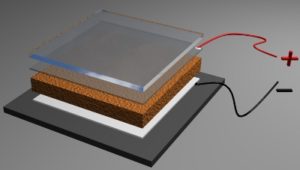Low-cost organic solar cells
Enhancement of low-cost organic solar cells by plasmonic structures for application and manufacturing in developing countries
Dr Lethy Jagadamma and Prof. Ifor Samuel
School of Physics and Astronomy

Today’s major source of energy (85%) – fossil fuel – is depleting rapidly and leads to major environmental problems including global warming. The Paris Agreement (COP21) in December 2015 has stressed the need to accelerate the low-carbon transformation of the global economy. The proposed solution is the transition to sustainable, renewable sources such as water, wind and sun. With 120,000 TW of solar power impinging on earth (with a practical extractable power of 600 TW), just 0.02% of the sun’s energy reaching our planet is sufficient to cover the annual energy demand of mankind. Yet, solar energy delivers only 0.1-0.2 % of the world energy consumption. This calls for affordable, clean energy research, development and deployment activities in the materials, engineering and system design in the field of solar cells so that modern energy services can be made accessible to remote areas of developing and less developed countries such as Brazil, Ethiopia and beyond.

Solar cells work by absorbing the incident solar light and converting it into positive and negative charges which are then collected at the respective electrodes. In silicon solar cells, the indirect bandgap requires thick active layers to compensate for its poor absorption. However, organic and hybrid perovskites have large absorption coefficients and require only 100-200 nm thickness. Their solution method of preparation and low temperature fabrication route requires only low energy input with energy payback time (EPBT) as low as 3 months, whereas the silicon based solar cell EPBT is as high as seven years. Thus, organic photovoltaics (OPVs) and hybrid perovskites are a promising choice for the solar energy harvesters for developing countries. Despite these promising attributes, the thin active layer of organic solar cells is not enough to absorb all the incident solar light. In this project, we are exploring how to enhance the absorption of light in organic/hybrid perovskite solar cells using plasmonic structures and by light diffracting nanostructures with collaborators in Brazil and Ethiopia. Through this approach, power conversion efficiency will be enhanced even with a reduced amount of active layer material. This opens up new application realms for organic solar cells such as a portable mobile phone charger, solar powered bags, tents topped with flexible solar cells which can increase the lighting and communication facility in remote areas of developing countries. In less developed countries like Ethiopia where the population is growing at 2.6 % annually and 80% of the population resides in rural areas, the extent of mobile phone ownership (24.7%) is higher than the fraction of households connected to the electrical grid (4.8%). Portable, flexible OPVs and hybrid solar cells can be an effective solution to this growing demand of off-grid power for lighting and telecom applications.
